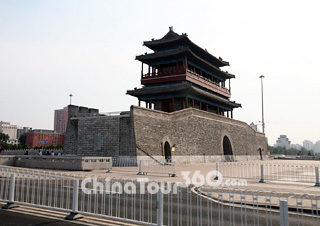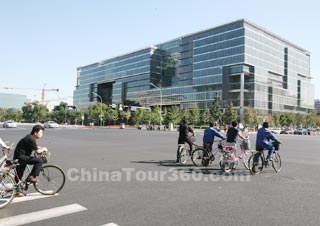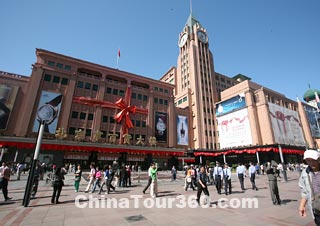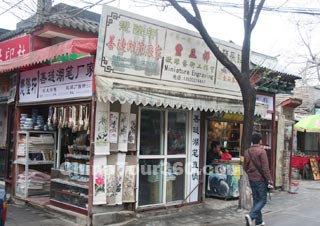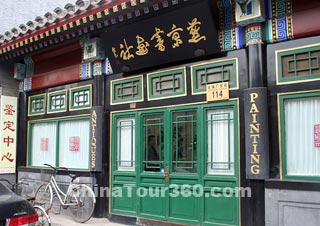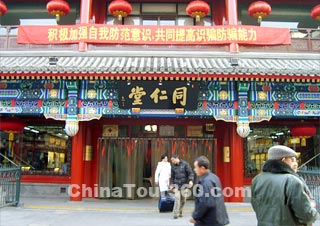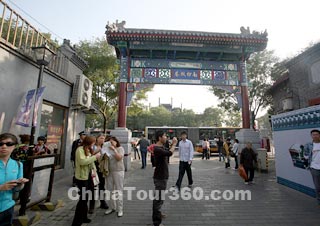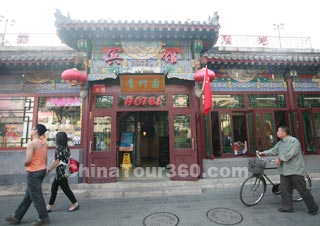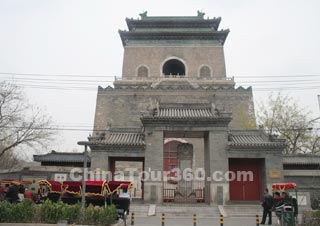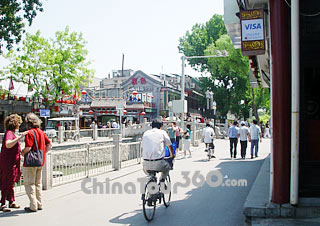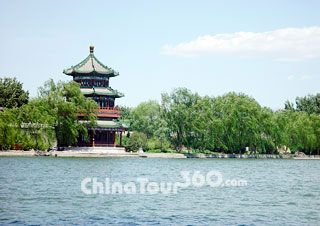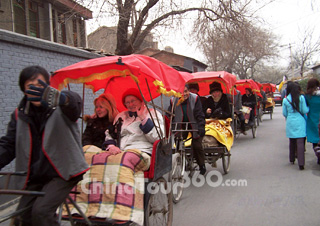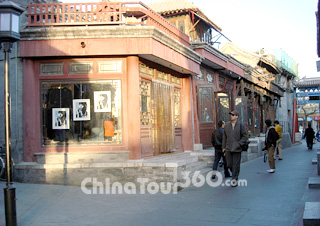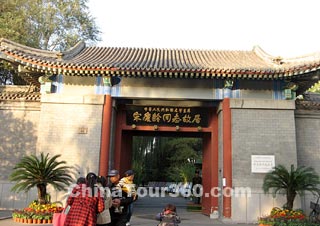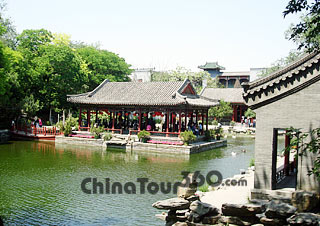Beijing Bike Tour
"Routing the Steps of the Old Beijing"
- Code: BK04
If you would like to enjoy as much freedom as you want during traveling and you are skilled at riding, then the bike tour would be a sound choice. For traveling by bike, you could stop whenever you like and it is feasible all year round except for the snowy and rainy days. For the following suggested itinerary, it is a classic bike route which presents a lot of history of old Beijing, especially of Hutong culture.
|
|
Tips:
1. During the day trip, you are kindly advised not to ride a bicycle that looks new and nice if you mean to enter into some of the scenic spots to visit. Because the good vehicles are always easily targeted by the thieves.
2. If you don’t have your own bicycles, you could rent it at Shichahai area.
Since this route is a little bit long, hereunder we would like to present it in three parts.
Part 1: The Ox Street - Niujie (Ox Street) Mosque - Caishikou - Liu Lichang West Street - Liu Lichang East Street - Yang Mei Zhu Xie Jie - Dashilan Street
The Ox Street is a famous ethnic cultural street with a long history in Beijing. More than twenty ethnic groups gathered here, among which the Huis are the most. Thus, it is featured by the Muslim flavor. For your information, you can follow the route of the Bus No. 10 from the West Tiananmen stop in the city center to Niujie (the Ox Street) by bike. You could have a taste of the famed “Cheese Wei” at the crossing of the Ox Street, but not eat too much as there are also so many other snacks waiting for you. Walking more than 100 meters towards south from the crossing, you could see the “Niujie (Ox Street) Muslim Supermarket”. All kinds of Muslim snacks can be found here. Across the street, it is “Turpan Restaurant” which enjoys a high reputation for its authentic dishes. Absolutely it should not be missed. We kindly suggest you eat your fill here to get yourselves prepared for the following bike tour.
|
|
After having meal at the Ox Street, riding to the south for a short while, then you will find the Niujie (Ox Street) Mosque. The mosque was initially built in the Liao Dynasty and continuously expanded and reconstructed in the Yuan, Ming and Qing dynasties. Being one of the most well known mosques in the world, which combines the Chinese classic palace style with the Arabic mosque style, Niujie Mosque ranks the first of the four mosques in Beijing. Since people cannot enter into the mosque casually for visiting, you may have a look at it from outside and take some photos.
Next, return to the crossing of the Ox Street, then turn to east and go down the Guang'anmennei Street, you will see a big crossing after riding about 1 kilometers, this is the so-called Caishikou. In the Qing Dynasty, Caishikou is a place of executing the prisoners. The prisoners would be brought out of the Xuan Wu Gate under escort, go by the Beheaded Bridge and then be sent to Caishikou. It was said that in this case, the prisoners would have no hope of survival. After having been put to death, the corpses of the prisoners were taken away and the bloodstain was covered by loess. Afterwards, some people sold vegetables and meat there and their business was very thriving. Hence Caishikou got its name. In English, Caishikou means food market crossing.
Riding to the north from Caishikou crossing along Xuanwumenwai Street, turning right from the south of SOGO, then moving eastward along the Qing Chang Hutong, you will get to Liu Lichang West Street soon. Liu Lichang Street is a well known cultural street in Beijing. There are many shops there selling books, “Wen Fang Si Bao” (the four instruments of study): brush pen, ink, paper and inkstone, and also many antique calligraphies and paintings. Many foreigners coming to Beijing will visit this street.
|
|
After passing by Liu Lichang West Street, you will get to Liu Lichang East Street. Turn right at the end of Liu Lichang East Street, you will see a small alley towards the east. This is Yang Mei Zhu Xie Jie. In the old times, this street is a cultural street. But now it has been very shabby.
Riding along Yang Mei Zhu Xie Jie towards east, you will reach Mei Shi Street at the end of it. Then turn right and ride towards south of Mei Shi Street, you will get to the famous commercial street ‘Dashilan’. After hundreds of years’ evolution, this street has become one of the important commercial streets.
Part 2: Dashilan Street - Huang Cheng Gen Heritage Park - Nanluo Guxiang (Mansion of Sengge Linqin's - The Central Academy of Drama - Yu'er Hutong - Former Residence of Mao Dun) - The Bell and Drum towers
Leaving Dashilan Street, riding along Qianmen Street and the East Square Road, you will then arrive at the East Chang’an Avenue. Continue to ride towards the east to reach Nanheyan Street, then turn left and ride towards the north, there is a long and narrow garden in the middle of the road. That is Huang Cheng Gen Heritage Park.
This park was open to the public on Sep 11, 2001. It starts from Chang’an Avenue from the south and ends at Ping’an Avenue in the north, totally 2.4 kilometers in length.
|
|
Passing Huang Cheng Gen Heritage Park, you are advised to turn left to ride along Ping’an Avenue. After riding a few minutes towards west, you could see a small street on the north side of the road with a memorial archway on which writes “Nanluo Guxiang”. It is one of the oldest blocks in Beijing.
Nanluo Guxiang starts from the East Bell Tower Street in the north and ends at the East Di An Men Street in the south. Taking “Nanluo Guxiang” as a spool thread, there are 8 Hutongs in its east and west separately. It shapes as the bone of the fish and looks like the centipede, thus, Nanluo Guxiang is also called the centipede alley. From the south to the north, the Hutongs in the west side of Nanluo Guxiang are called Fuxiang Hutong, Suoyi Hutong, Yu’er Hutong, Mao’er Hutong, Jingyang Hutong, Shajing Hutong, Heizhima Hutong and Qian Gulouyuan Hutong in turn. And those of the east side are Chaodou Hutong, Banchang Hutong, Dong Mianhua Hutong, Beibing Masi Hutong, Qinlao Hutong, Qianyuan En’si Hutong, Houyuan En’si Hutong and Ju’er Hutong.
From the Ming and Qing dynasties, Nanluo Guxiang had always been an area inhabited by the rich, the prominent officials and eminent personages. Now it has been one of the fashion focus areas in the city and most of the foreigners that traveling to Beijing will definitely visit here. Every bar at Nanluo Guxiang has free wireless internet access and the price levels there are relatively low. You could spend more time there.
From south to north, the first Hutong on the eastside of Nanluo Guxiang is called Chaodou Hutong. The No. 77 Mansion near the west exit of Chaodou Hutong is the Mansion of Sengge Linqin.
|
|
Continue to ride towards north along Nanluo Guxiang, the third Hutong on its eastside is Dong Mianhua Hutong, the famous Central Academy of Drama just locates here. This academy cultivated generations of students, and among which, some of them are well known all over the world, such as Zhang Ziyi, Gong Li, Jiang Wen, Chen Daoming and so on.
Opposite to Dong Mianhua Hutong on the west side of the road, it is Yu’er Hutong. The painting master Qi Baishi once resided at the No. 13 mansion here.
Riding along Yu’er Hutong from the east to the west until Dong Bu Ya Qiao Hutong and turning right, the place you are now at is Mao’er Hutong. Move towards east, return to Nanluo Guxiang, turn left and pass two Hutongs, you will get to Houyuan En’si Hutong. The No. 13 mansion here is the Former Residence of Mao Dun who was a great literature master in China. This residence is very simple and it is still left as it was when Mao Dun was living. Mao Dun spent his last 7 years in this small courtyard.
After passing the Former Residence of Mao Dun, riding along the East Drum Tower Street towards west, you could see two spectacular ancient buildings. Here are the Bell and Drum towers which are the telling time center in Yuan, Ming and Qing dynasties. In the old times, the ancients in China counted time by dividing the nights into 5 parts from 19:00 to 5:00am. Every part had 2 hours. When it was 19:00, the relevant persons in charge of this would beat the drum and strike the bell to inform the people that the sleeping time was coming. At 21:00, 23:00, 1:00 and 3:00, they would only strike the bell but not beat the drum in order not to interfere people who were asleep. When it was 5:00 in the morning, again, they would beat the drum and strike the bell to tell people that it was time to get up. The way that they beat the drum was beating the drum 18 times quickly first and then another 18 times slowly, this would be treated as one round. Totally, they would beat 3 rounds. That was 108 times. Striking the bell was the same. Now the Bell and Drum towers have lost their function of telling the time. But when there are holidays and festivals, people can also hear the deep and vigorous beating of the drum. This has been a famous scene in Beijing.
|
|
Part 3: The Grand Canal Heritage at Jishuitan - Jin Ding Bridge - Qian Hai - Yin Ding Bridge - Yandai Xiejie- Hou Hai - Former Residence of Song Qingling - Jiumen Xiaochi - Prince Gong's Mansion - Furen University - Former Residence of Mei Lanfang
Riding along Di An Men Wai Street towards south from the Drum Tower for about 400 meters, then turn right, you could see a three-arch white marble stone bridge, that is Jin Ding Bridge. Not far from Jin Ding Bridge in the north, a big stone lies there and the character on which indicates that it is the Grand Canal Heritage at Jishuitan. Do you know? Here is exactly the terminal of the Grand Canal.
Shichahai area is divided into three water parts. They are Qian Hai (means the front lake), Hou Hai (means the back lake) and Xi Hai (means the Western Lake). The area that the Jin Ding Bridge locates at belongs to Qian Hai. There is a small island in Qian Hai Lake. In summer, people can go boating on Qian Hai Lake and people could go skiing there in winter. Many bars and shops are surrounding the lake. Riding around the lake with the breeze blowing slightly and the sallow swaying, you could stop your steps to enjoy the beautiful scenery or take some photos to retain the sweet memory. How relaxing!
|
|
Later, you can ride along the east edge of Qian Hai towards the northwest. Soon you could see there is another bridge on the narrowest part of Qian Hai, which is the so called Yin Ding Bridge. This bridge connects Qian Hai and Hou Hai and it is one of the eight small wonders of Peking. Going down the bridge and riding a few meters ahead, you could see another Hutong, which is the well known Yandai Xiejie, a famous commercial street with hundreds of years’ history. In English, Yandai means tobacco pipe. This Hutong was originally named as Gulou Xiejie, means Drum Tower cornered street. But in the late Qing dynasty, it was renamed as Yandai Xiejie. It was said that during the late Qing dynasty, many of the scions of Manchu eight banners were keen on smoking and the tobacco pipe shops in this street were quite prosperous. That is why this Hutong got its name. Nowadays, the shops there mainly sell some gadgets with local flavor.
The west part of Yin Ding Bridge is called Hou Hai. As we had mentioned in the above, Shichahai area is divided into three water parts, namely Qian Hai, Hou Hai and Xi Hai, but the folks always consider these three parts as Hou Hai as a whole.
|
|
Go straight from the north side of Hou Hai towards the west, the gate of the Former Residence of Song Qingling can be seen among the trees. Mrs. Song Qingling was Sun Yat-sen’s wife and also one of the honorary chairmen of People’s Republic of China. If time allows, you could enter into it for visiting. The admission fee is CNY20.00 net per person. However, it will not be open to the public on Monday and from Nov 01 to the next end of February. Getting out of the Former Residence of Song Qingling, continue to ride ahead for less than 100 meters, the Jiumen Xiaochi appears. Xiaochi means snacks while Jiumen means nine gates. As there are nine gates in Beijing, Jiumen Xiaochi indeed refers to Beijing snacks. The average cost for having meals at Jiumen Xiaochi is about CNY50.00 to CNY70.00 net per person.
Leaving from Jiumen Xiaochi, going straight along the lake side of Hou Hai, you could see the Prince Gong's Mansion. This residence was originally the mansion of He Shen, the powerful minister of the emperor Qian Long in the Qing dynasty. The emperor Jia Qing’s brother, Yong Lin also resided here after He Shen. In the year of 1851, Prince Gong resided here and became the third master of this mansion. After that, this mansion was renamed as Prince Gong's Mansion and this name has been used for many years until today. There is a saying that ‘one Prince Gong's Mansion, half the Qing dynasty history’. From that we can see how important a role the Prince Gong's Mansion played in the Qing history. In October, 1996, the back yard garden of this mansion was open to the public. And from August 20, 2008, the whole mansion was open to the public after being repaired.
After passing through the Prince Gong's Mansion, you can see there is an east-west Hutong named Ding Fu Street. Riding toward west along this street for a short while, the No. 13 middle school appears and the site of Furen University is next to it. In the beginning of the 20th century, Furen University, along with the Peking University, Tsinghua University and Yanching University were the four most famous universities in Peking. But now Furen University had been a past and the site is now used as a branch campus of Normal University.
|
|
Riding continuously along the Ding Fu Street towards west for about 400 meters, you could find the Former Residence of Mei Lanfang at the junction of the Deshengmennei Street. Mei Lanfang was a world-famous Peking Opera master and he spent his last 10 years here.
Until now, this bike travel route comes to an end. Hope you will have a better understanding of the culture of the old Beijing, especially of the old Peking Hutong culture.



